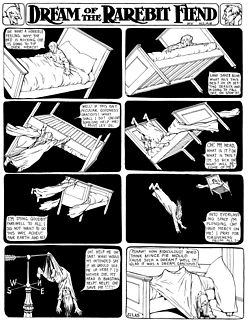Dream of the Rarebit Fiend
| Dream of the Rarebit Fiend | |
|---|---|

January 28, 1905, Rarebit Fiend episode
|
|
| Author(s) | Winsor McCay |
| Launch date | September 10, 1904 |
| End date | c. 1925 |
| Alternate name(s) |
|
| Publisher(s) | New York Herald |
| Preceded by | Little Sammy Sneeze |
| Followed by | Little Nemo |
Dream of the Rarebit Fiend is a newspaper comic strip by American cartoonist Winsor McCay, begun September 10, 1904. It was McCay's second successful strip, after Little Sammy Sneeze secured him a position on the cartoon staff of the New York Herald. Rarebit Fiend appeared in the Evening Telegram, a newspaper published by the Herald. For contractual reasons, McCay signed the strip with the pen name "Silas".
The strip had no continuity or recurring characters, but a recurring theme: a character has a nightmare or other bizarre dream, usually after eating a Welsh rarebit—a cheese-on-toast dish. The character awakens in the closing panel and regrets having eaten the rarebit. The dreams often reveal unflattering sides of the dreamers' psyches—their phobias, hypocrisies, discomforts, and dark fantasies. This was in great contrast to the colorful fantasy dreams in McCay's signature strip Little Nemo, which he began in 1905. Whereas children were Nemo's target audience, McCay aimed Rarebit Fiend at adults.
The popularity of Rarebit Fiend and Nemo led to McCay gaining a contract in 1911 with William Randolph Hearst's chain of newspapers with a star's salary. His editor there thought McCay's highly skilled cartooning "serious, not funny", and had McCay give up comic strips in favor of editorial cartooning. McCay revived the strip in 1923–1925 as Rarebit Reveries, of which few examples have survived.
A number of film adaptations of Rarebit Fiend have appeared, including Edwin S. Porter's live-action Dream of a Rarebit Fiend in 1906, and four pioneering animated films by McCay himself: How a Mosquito Operates in 1912, and 1921's Bug Vaudeville, The Pet, and The Flying House. The strip is said to have anticipated a number of recurring ideas in popular culture, such as marauding giant beasts damaging cities—as later popularized by King Kong and Godzilla.
...
Wikipedia
